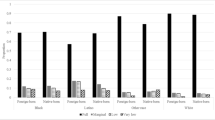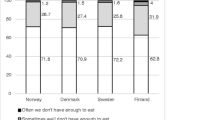Abstract
Prevalence of food insecurity (FI) among Latinos in the United States is almost double the national average. To better understand FI among Latinos, potential risk factors beyond poverty, including acculturation indicators and smoking status, were explored. Cross-sectional data from 6,681 Latino adults from the 1999–2008 National Health and Nutrition Examination Surveys were used. Partial proportional odds (PPO) models were used to estimate associations of FI, including cigarette smoking and acculturation. The PPO models indicated that compared with never smokers, current smokers had significantly higher odds of FI (odds ratios ranged from 1.32 to 1.51 across models). Lower levels of acculturation and poverty and being a younger or middle-aged adult were also significantly associated with FI. Among Latinos, current smoking and low acculturation are important risk factors for FI. Current smoking and low acculturation may exacerbate nutritional deprivation in a population that is already disproportionally affected by poverty and poor health outcomes.
Similar content being viewed by others
References
Hamilton WL, Cook JT, Thompson WW, Buron LF, Frongillo EA, et al: Household food security in the United States in 1995: summary report of the Food Security Measurement Project. Alexandria: U.S. Department of Agriculture, Food and Consumer Service; 1997. http://www.fns.usda.gov/ora/menu/published/FoodSecurity/SUMRPT.PDF.
Bartfield J, Dunifon R. State-level predictors of food insecurity among households with children. J Policy Anal Manag. 2006;25(4):921–42.
Cutler-Triggs C, Fryer GE, Miyoshi TJ, Weitzman M. Increased rates and severity of child and adult food insecurity in households with adult smokers. Arch Pediatr Adolesc Med. 2008;162(11):1056–62.
Ramsey R, Giskes K, Turrell G, Gallegos D. Food insecurity among adults residing in disadvantaged urban areas: potential health and dietary consequences. Public Health Nutr. 2012;15(2):227–37.
U.S. Census Bureau: The American Community: Hispanics 2004. Washington, DC: U.S. Department of Commerce, Economics and Statistics Administration, U.S. Census Bureau; 2007. http://www.census.gov/prod/2007pubs/acs-03.pdf.
Coleman-Jensen A, Nord M, Andrews M, Carlson S: Household food security in the United States in 2010. ERR-125. U.S. Department of Agriculture, Economic Research Report; 2011. http://www.ers.usda.gov/publications/err-economic-research-report/err125.aspx.
Vozoris NT, Tarasuk VS. Household food insufficiency is associated with poorer health. J Nutr. 2003;133(1):120–6.
U.S. Department of Health and Human Services: How tobacco smoke causes disease: the biology and behavioral basis for smoking-attributable disease. A 2010 Report of the Surgeon General. Rockville, MD: U.S. Department of Health and Human Services, Public Health Service, Office of the Surgeon General; 2010. http://www.cdc.gov/tobacco/data_statistics/sgr/2010/index.htm.
James WP, Nelson M, Ralph A, Leather S. Socioeconomic determinants of health. The contribution of nutrition to inequalities in health. BMJ. 1997;314(7093):1545–9.
Centers for Disease Control and Prevention: Tobacco use among U.S. racial/ethnic minority groups—African Americans, American Indians and Alaska Natives, Asian Americans and Pacific Islanders, and Hispanics. A Report of the Surgeon General. Atlanta, GA: U.S. Department of Health and Human Services, Centers for Disease Control and Prevention, National Center for Chronic Disease Prevention and Health Promotion, Office on Smoking and Health; 1998.
Escarce JJ, Morales LS, Rumbaut RG. The health status and health behaviors of Hispanics. In: Tienda M, Mitchell F, editors. National Research Council (US) Panel on Hispanics in the United States. Hispanics and the future of America. Washington: National Academies Press; 2006. p. 362–409.
Drewnowski A, Specter SE. Poverty and obesity: the role of energy density and energy costs. Am J Clin Nutr. 2004;79(1):6–16.
Marin G, Sabogal F, Marin BV, Otero-Sabogal R, Perez-Stable EJ. Development of a short acculturation scale for Hispanics. Hisp J Behav Sci. 1987;9(2):183–205.
Dhokarh R, Himmelgreen DA, Peng YK, Segura-Perez S, Hromi-Fiedler A, et al. Food insecurity is associated with acculturation and social networks in Puerto Rican households. J Nutr Educ Behav. 2011;43(4):288–94.
Kaiser LL, Melgar-Quinonez HR, Lamp CL, Johns MC, Sutherlin JM, Harwood JO. Food security and nutritional outcomes of preschool-age Mexican-American children. J Am Diet Assoc. 2002;102(7):924–9.
Dave JM, Evans AE, Saunders RP, Watkins KW, Pfeiffer KA. Associations among food insecurity, acculturation, demographic factors, and fruit and vegetable intake at home in Hispanic children. J Am Diet Assoc. 2009;109(4):697–701.
Perez-Escamilla R. Dietary quality among Latinos: is acculturation making us sick? J Am Diet Assoc. 2010;110(5):S36–9.
Bethel JW, Schenker MB. Acculturation and smoking patterns among Hispanics: a review. Am J Prev Med. 2005;29(2):143–8.
Armour BS, Pitts MM, Lee CW. Cigarette smoking and food insecurity among low-income families in the United States, 2001. Am J Health Promot. 2008;22(6):386–92.
Hiscock R, Bauld L, Amos A, Fidler JA, Munafo M. Socioeconomic status and smoking: a review. Ann N Y Acad Sci. 2012;1248:107–23.
Centers for Disease Control and Prevention. Vital signs: current cigarette smoking among adults aged ≥18 years—United States, 2005–2010. Morb Mortal Wkly Rep. 2011;60(35):1207–12.
Lopez MH, Cohn D: Hispanic poverty rate highest in new supplemental census measure. Washington: Pew Research Center, Pew Hispanic Center; 2011. http://www.pewhispanic.org/files/2011/11/148.pdf.
Wang H, Sindelar JL, Busch SH. The impact of tobacco expenditure on household consumption patterns in rural China. Soc Sci Med. 2006;62(6):1414–26.
John RM, Ross H, Blecher E. Tobacco expenditure and its implications for household resource allocation in Cambodia. Tob Control. 2012;21(3):341–6.
U.S. Department of Health and Human Services: Hispanic/Latino profile. Rockville, MD: U.S. Department of Health and Human Services, Office of Minority Health; 2012. http://minorityhealth.hhs.gov/templates/browse.aspx?lvl=3&lvlid=31.
U. S. Department of Health and Human Services, Centers for Disease Control and Prevention, National Center for Health Statistics: National Health and Nutrition Examination Survey (NHANES), 2007–2008. ICPSR25505-v3. Ann Arbor, MI: Inter-university Consortium for Political and Social Research; 2012. doi:10.3886/ICPSR25505.v3.
Centers for Disease Control and Prevention: Disability and Health Data System. Health topic data guide: smoking status. [no date]; Page last updated Feb 6, 2013. http://dhds.cdc.gov/guides/healthtopics/indicator?i=smokingstatus.
Coonrod DV, Balcazar H, Brady J, Garcia S, Van Tine M. Smoking, acculturation and family cohesion in Mexican-American women. Ethn Dis Autumn. 1999;9(3):434–40.
Kepka D, Coronado G, Rodriguez H, Thompson B. Acculturation and HPV infection among Latinas in the United States. Prev Med. 2010;51(2):182–4.
Lara M, Gamboa C, Kahramanian MI, Morales LS, Bautista DE. Acculturation and Latino health in the United States: a review of the literature and its sociopolitical context. Annu Rev Public Health. 2005;26:367–97.
Castro Y, Reitzel LR, Businelle MS, Kendzor DE, Mazas CA, Li Y, et al. Acculturation differentially predicts smoking cessation among Latino men and women. Cancer Epidemiol Biomarkers Prev. 2009;18(12):3468–75.
Coronado GD, Thompson B, McLerran D, Schwartz SM, Koepsell TD. A short acculturation scale for Mexican-American populations. Ethn Dis. 2005;15(1):53–62.
Williams R. Generalized ordered logit/partial proportional odds models for ordinal dependent variables. Stata J. 2006;6(1):58–82.
Stromberg U. Collapsing ordered outcome categories: a note of concern. Am J Epidemiol. 1996;144(4):421–4.
Trinidad DR, Gilpin EA, Messer K, White MM, Pierce JP. Trends in smoking among Hispanic women in California: relationship to English language use. Am J Prev Med. 2006;31(3):257–60.
Wilkinson RG. Socioeconomic determinants of health: health inequalities: relative or absolute material standards? BMJ. 1997;314(7080):591–5.
Kendzor DE, Businelle MS, Costello TJ, Castro Y, Reitzel LR, et al. Financial strain and smoking cessation among racially/ethnically diverse smokers. Am J Public Health. 2010;100(4):702–6.
NC Latino Health: A report from the Latino health task force North Carolina Institute of Medicine in collaboration with El Pueblo, Inc. Durham, NC: North Carolina Institute of Medicine; 2003. http://www.nciom.org/wp-content/uploads/NCIOM/projects/latino/latinopub/fullreport.pdf.
Hadley C, Galea S, Nandi V, Nandi A, Lopez G, Strongarone S, et al. Hunger and health among undocumented Mexican migrants in a US urban area. Public Health Nutr. 2008;11(2):151–8.
Acknowledgments
This project has been funded in part with Federal funds from the National Cancer Institute, National Institutes of Health, U.S. Department of Health and Human Services, under Contract No. HHSN261201000043C.
Conflict of interest
None.
Author information
Authors and Affiliations
Corresponding author
Rights and permissions
About this article
Cite this article
Iglesias-Rios, L., Bromberg, J.E., Moser, R.P. et al. Food Insecurity, Cigarette Smoking, and Acculturation Among Latinos: Data From NHANES 1999–2008. J Immigrant Minority Health 17, 349–357 (2015). https://doi.org/10.1007/s10903-013-9957-7
Published:
Issue Date:
DOI: https://doi.org/10.1007/s10903-013-9957-7




